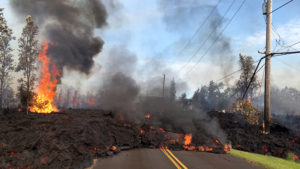Most of those of us who live in the 48 contiguous United States of America don’t have to worry about the forces of nature that are putting the folks of Hawaii in such peril at the moment.
Kilauea is erupting on the island of Hawaii. It’s showing no sign of letting up. It’s covering streets and highways with lava. I haven’t heard of any loss of life. The volcano has become — for years, apparently — part of people’s daily existence. It is getting worse.
My heart goes out to those in harm’s way.
I have been reading some material in the New York Times and other publications about comparisons between what is happening in Hawaii and what could happen along other volcanic mountain chains in the United States.
I was particularly struck by the speculation surrounding the Cascade Range, which traverses north and south from British Columbia, through Washington, Oregon and into California.
Of all the things one never expects to see in their lifetime, a volcanic eruption was one of them. That all changed for me in the spring of 1980, when Mount St. Helens, a peak that once stood about 9,700 above sea level in southwest Washington, exploded in spectacular fashion. The volcanic explosion occurred on May 18, 1980, killing about 70 individuals. It was the story of the decade for those of us living in the Pacific Northwest.
I was living in the city of my birth, Portland, Ore., about 50 miles south of the peak, which now stands at about 8,400 feet, given that so much of its peak was blown apart by the titanic blast.
Mount St. Helens’s eruption produced a vast crop of armchair vulcanologists who became “experts” based on what they heard, read and possibly felt in their bones about what might happen to any of the other volcanic peaks along the Cascade Range.
Mount Hood stands like a sentinel to the east of Portland. It’s a glorious peak that stands 11,250 feet along the horizon. Will it blow apart? That’s been the subject of some discussion since Mount St. Helens blew apart. If it does, I’ll tell you it will create serious damage along its southern face, which was shaped by its latest eruption, which occurred, oh, a long time ago. The mountain is considered “dormant,” as it seeps gas out of the caldera near its summit.
So, it is with some interest that many of us are watching the drama unfold in Hawaii. We’ve lived through it, too.
